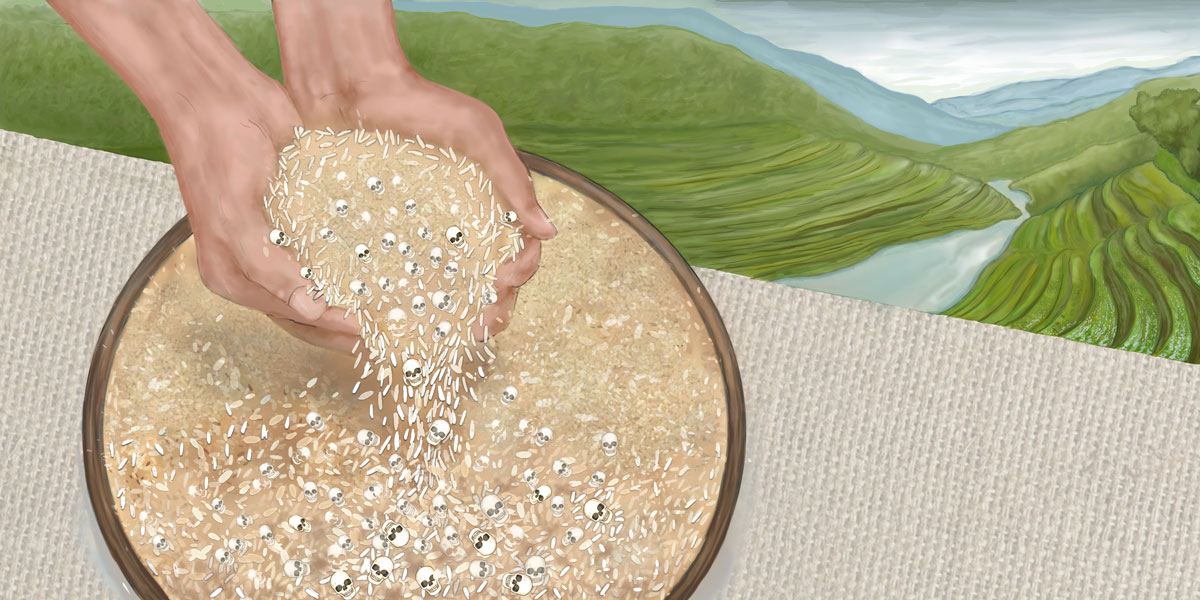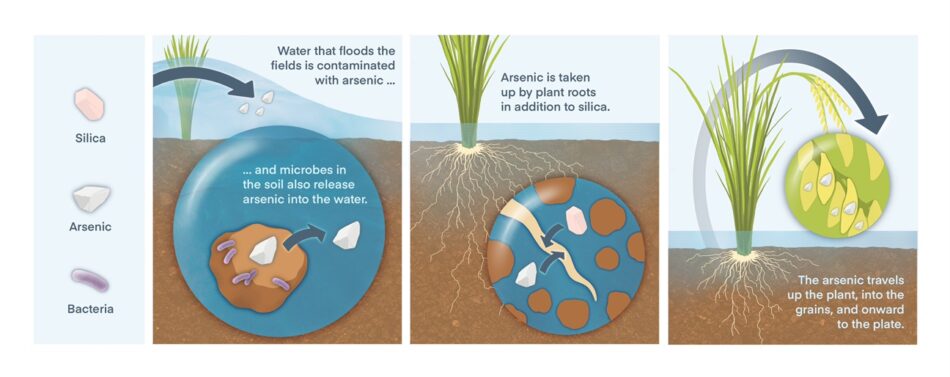The Plight of Rice
Rice feeds half the world, but climate change threatens to toxify its grains, Nikk Ogasa reports. Illustrations by Joy Grannis and Dana Smith.

Illustration: Joy Grannis
Maren Biswas rises from a metal chair, unbuttoning his shirt to reveal the markings on his torso. Dark, dime-sized lesions mottle his back, chest, and arms.
“They are from arsenic,” he says, via a translator, before proceeding to redress himself. Biswas is a 65-year-old day laborer, who lives in a small village called Madhusudankati, located about 65 kilometers from the city of Kolkata in West Bengal, India.
The blotches on Biswas’ skin weren’t the only effects of the toxin. In 2000, he first felt deep pains in his body. “I went to the hospital, and they told me it was arsenic poisoning.”
For months Biswas’ symptoms kept him off the farm fields where he made his living. But with no other income stream to support his wife and children, he returned to his job, still afflicted by pain. “I had to work,” he said.
Biswas’ diagnosis was not unique—around the same time he visited the hospital, members from over 100 families in his small village also learned they had arsenic poisoning. And compared to many others, Biswas had mild symptoms. In more severe cases, arsenic poisoning can lead to gangrene, cardiovascular and neurological problems, birth defects, and skin, lung, bladder, and kidney cancers.
In the region where Biswas lives, known as the Ganga Basin, arsenic poisoning has been a historic and widespread phenomenon. The Ganga Basin is the watershed of the famous Ganges River, and drains large areas of India, Nepal, Bangladesh, and China. Millions of people call the basin home, and for decades, arsenic has slowly poisoned them.
The rise of arsenic
In the 70s, people across the Ganga Basin began installing shallow tube wells, to access underground reservoirs of water that were free of the disease-causing pathogens plaguing surface waters, says M. Rafiqul Islam, a soil scientist at the Bangladesh Agricultural University. But no one realized that many of these wells drew from aquifers nestled in arsenic-bearing rock layers, and that the water itself contained arsenic leached from the rocks. Unsuspectingly, millions of people began to drink the toxic water from these wells, and arsenic started to slowly assault their bodies.
But drinking water wasn’t the toxin’s only path into the human body. Farmers also use the arsenic-laden water to irrigate their crops, says Islam. And the most contaminated of these crops is rice.
Rice is vulnerable to arsenic contamination because it grows in flooded fields, called paddies. Paddy soils lack oxygen, and the microbes that thrive in this so called “anoxic” environment liberate arsenic from the soil so it can flow freely in the water. Once the arsenic is in the water, rice plants can draw it in through their roots. And from there, the toxin is distributed throughout the plants’ tissues and grains.
Illustration: Dana Smith
The rice plant also has an unwitting fondness for arsenic, because rice uses the element silica to build its tissues and grains. Unfortunately, arsenic and silica are chemically similar, and the rice plant has a hard time telling them apart. As a result, the plant sucks in arsenic from the soil in a mistaken attempt to absorb the silica that it needs, and incorporates the poison into its grains.
And though arsenic’s assault on rice is most dire in the Ganga Basin, it may grow to become a global problem. Around 7 years ago, scientists began calling attention to the impact that climate change might have on arsenic levels in in rice. And since then, studies have shown that under future climate scenarios, rice plants accumulate greater amounts of arsenic in their grains. This threat is no trivial matter, as the global rice crop feeds about half of humanity. Even regions that are currently unconcerned by toxic rice, such as California, will eventually be forced to come up with solutions to save their rice crops.
The amount of harmful arsenic in rice is going to double in the future, says Tianmei Wang, a biogeochemist at Stanford University. “That is really alarming—we need to get prepared for that.”
And toxification isn’t the only threat facing the global rice crop. Arsenic impacts not only the quality of the rice, but also its quantity. Researchers know that rice fields contaminated with the toxin produce smaller harvests. Now, they’ve discovered rice has a thermal tipping point—above certain temperatures, rice yields plummet drastically.
The toxic threat
Eva Marie Muehe, a biogeochemist at the University of Tübingen, in Germany, stands at the forefront of a newfound effort in science—one that seeks to understand how climate change will impact the infiltration of arsenic in rice. In 2019, Muehe led a study based on greenhouse experiments at Stanford University, where she was situated at the time. These experiments showed how more arsenic will infiltrate rice plants under future climate conditions. Muehe and her team published their findings in Nature Communications, and many researchers have since recognized that paper as a seminal piece of work.
The researchers grew a Californian variety of rice in a local soil, inside of greenhouses where they could control temperatures and carbon dioxide levels. In several of the greenhouses the team adjusted these conditions to simulate future climate scenarios.
The experiments revealed that rice grown under the future climate conditions produced fewer grains than those grown under modern climate conditions.
“But what was also surprising is that we increased the inorganic arsenic—that’s the more toxic fraction of arsenic—in the grain,” says Muehe.
By increasing the temperature, we enhanced the activity of the microbes living in the rice paddy soils, Muehe says. That led to greater amounts of arsenic moving out of the soil and into the water, and the rice plants sucked up this extra arsenic.
The form of arsenic mattered too. Arsenic compounds can be grouped into two categories: organic and inorganic. Inorganic arsenic is far more harmful to the human body than organic forms. The experiments revealed that under higher temperatures, inorganic arsenic levels doubled in rice grains, while organic arsenic levels stayed the same.
Arsenic is present in every rice paddy in the world, though in most regions the toxin exists at very low levels. The experiments conducted by Muehe’s team show that even in regions where soil arsenic levels are low, arsenic levels in rice will escalate as temperatures and carbon dioxide levels climb. Higher levels of arsenic in rice are most dangerous to infants and small children, and for individuals with poor health, even low dosages of arsenic can be harmful, says Muehe.
More recently, Muehe and her colleagues have experimented with other varieties of rice, and with Cambodian and Bangladeshi soils, and found similar results. “How much the plant is affected, what that means for total yield, and the amount of arsenic in the grain varies,” she says. But for each of the soils tested, and for each variety of rice, the trends are the same, says Muehe. “You have more arsenic in the plant when there’s climate change.”
A dire threat to yields
But the increasing toxicity is only half the story—the amount of rice produced will be affected by climate change too. “Arsenic is not just toxic for us, it’s also toxic for the plant,” says Muehe. As rice plants take in more arsenic, they produce fewer grains. Though scientists already understood warmer climates could decrease yields by stressing plants, the added impact of arsenic had not been accounted for. According to Muehe, “We’re currently overestimating how much rice we’ll produce in the future.” And in a world where so many depend on rice, with no alternative food staple, that is a dire problem.
Since 2019, Muehe and her former colleagues at Stanford University have continued to study the impact of climate change on rice. One of Muehe’s colleagues, Tianmei Wang, has been experimenting with Bangladeshi rice and soils and found a startling result.
During the summer, while harvesting rice from an experiment, Wang noticed something odd with the plant’s husks, which are the part of the plant within which rice grains form. She found that many of the husks in her experiment were empty.
“I wasn’t sure why the yield was so low,” says Wang, “and so I went back to the control station and checked the climate data.”
Wang’s experimental logs revealed that a summer heat wave had spiked the growing temperatures in her experiments. The heat wave had subjected the rice plants to temperatures beyond what Wang and her colleagues had planned. This led to a surprising discovery—a temperature threshold above which the rice plants struggled to produce grains.
“If you move beyond that temperature, then you’ll see a huge yield decrease, about a 90% decrease, just due to heat stress alone,” says Wang.
For the variety of rice Wang was experimenting with, that temperature threshold was about 38 degrees Celsius, or 100 degrees Fahrenheit. Because each variety of rice will react to heat stress differently, the global rice crop will not experience a sudden, dramatic loss in crop. Rice as a global crop will instead experience a gradual decline in productivity. But the rate of this decrease will accelerate as temperatures rise.
“I feel for the human beings living 50 years after us.”
“Initially, the decrease will be slow. And you’ll just wonder if it’s just a dip,” says Muehe. “But eventually it will decrease faster and faster, as temperatures continue to increase.”
For those of us that don’t eat much rice, this might not be a problem. But for around 3.5 billion people rice is a staple food, meaning they likely consume it several times a day. Even a small decline in global rice production could have major repercussions for populations that depend on rice. “I feel for the human beings living 50 years after us,” says Wang.
Most of the world’s rice is grown in Asia, with China and India the largest producers. Data from United Nations FAO.
Searching for a solution
“Whether we can produce enough rice in the future climate, is very, very scary,” says Manoj Menon, a soil scientist at the University of Sheffield in the United Kingdom. Solutions will need to be fine-tuned to account for the nuances of individual regions. Local economics, culture, and ecology can all impact the effectiveness of arsenic mitigation efforts.
Last year, for instance, Menon published a cooking method that was shown to remove a substantial amount of inorganic arsenic from rice—73% from white rice, and 54% from brown rice. The method, called “parboiling and adsorption,” entails boiling rice in a bath of water, discarding the water, and then continuing to cook the rice with fresh water. But, Menon says, “This method is not suitable for India.” Indians don’t traditionally cook rice this way and convincing them to change could be difficult. Parboiling and adsorption is better suited to Western countries, he says.
And while Menon’s cooking method is effective for removing arsenic from grains, it does not address the yield decrease problem. But an agricultural method known as “alternative wetting and drying,” or AWD, offers a promising solution.
AWD, also known as “intermittent flooding,” entails flooding paddies several times a day, and allowing them to dry out between each flood. This practice contrasts with the traditional method of leaving rice paddies continuously inundated. Not only does AWD conserve water, but it oxygenates soils, helping to decrease the amount of arsenic taken in by the plants, says Menon.
But in the Ganga Basin, AWD is not picking up well, says Humnath Bandhari, the Bangladesh representative for the International Rice Research Institute. Today, AWD is used on less than 5% of Bangladesh’s rice growing area.
“In Bangladesh, when well owners charge for water, they charge on a seasonal basis, and not by volume used,” Bandhari says. “So farmers have no economic incentive to conserve water.” At the moment IRRI is trying to educate Bangladeshi farmers on the benefits of AWD, and encourage well owners to charge farmers only for the amount of water they use.
Experts are also looking towards the engineering arsenic resistant rice strains as a solution to the arsenic crisis. Debasis Chakrabarty, a principal scientist from the CSIR-National Botanical Research Institute in Lucknow, India, has been developing a genetically modified strain of rice that is resistant to toxic arsenic. To create the strain, Chakrabarty and his colleagues went out into the field and collected samples of a fungus living in the arsenic-laden soils of West Bengal. The fungus they sampled, called Westerdykella aurantiaca, possessed the ability to convert inorganic arsenic into less toxic organic arsenic. Chakrabarty and his team isolated the gene in the fungus responsible for the arsenic conversion and then inserted that gene into rice plants. Their new, genetically modified variety of rice was able to turn inorganic arsenic into an organic form, and then release that organic arsenic into the atmosphere. Put simply, the rice plant’s grains were free of harmful arsenic.
But a ban on genetically modified organisms in India has prevented Chakrabarty and his team from testing their transgenic rice in the field. Chakrabarty is looking for partners from other countries, such as Bangladesh, to test the rice.
In 2016, recognizing the threat that rice arsenic posed to the health of the international community, the United Nations’ Codex Alimentarius Commission, or CAC, adopted the standard that no more than 0.35 milligrams of inorganic arsenic may be present in each kilogram of husked rice. But we can’t force countries to follow this limit, says Sasha Koo-Oshima, Deputy Director of the Land and Water Division at the United Nations Food & Agriculture Division. “They are guidelines. Countries can then come up with their own standards.” But today nations like Bangladesh and India face other, more pressing concerns, such as rising sea levels and contaminated drinking water, that overshadow arsenic in rice, says Koo-Oshima.
While Muehe agrees that prioritizing these issues is probably the right decision, she also believes governments should already be concerned by the impact climate change will have on rice. The countries that share the Ganga Basin have large, growing populations that depend heavily on rice. Climate change will bring about a loss in yields that could spell disaster for them.
The next step
Back in Madhusudankati, Maren Biswas no longer suffers from the pains he once felt. Though lesions still mar his skin, he says “they are not as bad as before.” Water treatment plants constructed by Indian NGO Sulabh International now provide Biswas’ community with clean, arsenic-free water.
But much of the Ganga Basin is still riddled with the toxin, its rice paddies inundated with arsenic-rich water. And with climate change following the Intergovernmental Panel on Climate Change’s worst-case predictions, humanity’s most important crop is in danger. Eventually, rice yields will fall, and before that, rice will grow increasingly toxic.
“We’ve just identified the problem, we are nowhere close to finding an answer,” Muehe says. “That is the next step.”
This story contains material from “Rice feeds half the world. Climate change’s droughts and floods put it at risk,” which was published by the author on September 24 in Science News.
© 2021 Nikk Ogasa / UC Santa Cruz Science Communication Program

Nikk Ogasa
Author
M.S. (geology) McGill University
B.S. (earth science) University of California, Santa Cruz
Internships: The Monterey Herald, Inside Science, Science, Science News, Scientific American
I once spent three days in a cramped, dusty room, dicing hundreds of black cobbles with a screeching table saw. The blocks I cut would later be sliced paper thin and beamed with a laser to reveal chemical clues to their two-billion-year-old history. Geology was grueling work, but there was a story in those stones, and I meant going to get it out of them.
Though my days with the rock saw are behind me, I’m still chasing after what I believe are the most fascinating and important stories in science. I’ve covered a wide range of topics, ranging from the possibility of life on Mars to firefighting strategies to self-decapitating sea sponges. My stories have been published in Science, Scientific American, Science News, The Scientist, Inside Science, Eos, Mongabay, the San Jose Mercury News, San Jose Inside, and the Monterey Herald, and my work has been republished by outlets like the Washington Post, ABC News, Yahoo News, Astronomy, and the East Bay Times.

Joy Grannis
Illustrator
Joy Grannis is an artist and illustrator based out of Portland, Maine. Her connection to nature and creativity stems from her experience growing up on a sustainable homestead in rural Maine. She and her siblings spent countless hours running through pine forests, looking for the perfect stones tumbled by the Atlantic ocean, foraging, growing food, and creating. This foundation led her to study environmental planning and policy where she formed connections with the green building and sustainable urban design communities and fed her passion for promoting the greening of city environments.
Joy has a special interest in native plant communities and the ecosystems in which they thrive and enjoys capturing this world in a variety of mediums. She hopes that her work will inspire people to conserve and protect all the tiny beautiful things around them, no matter where they are in the world

Dana Smith
Illustrator
My work explores the structures and patterns of the natural world. Using my background in fine art, experience design (UX), and interactive installation design, my work strives to renew our fascination with the world around us by revealing the unseen, and connecting the seemingly disparate.
In my quest to be a modern renaissance thinker, I formally studied product/industrial design, psychology, fine art, and somatics — alongside a host of other informal knowledge quests about what makes us and the world around us the way it is. Current areas of inspiration include the potential of biomimicry, the science of color, and the powerful energy of the Monterey Bay intertidal zone.
